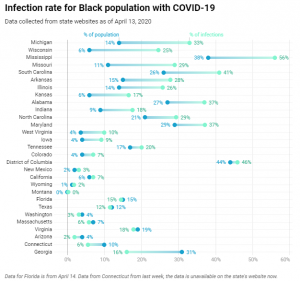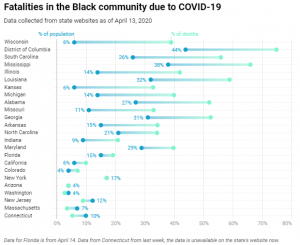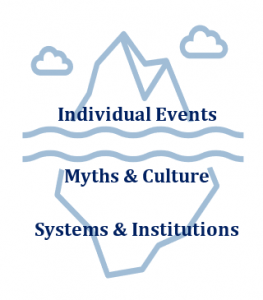No doubt, over the next few days or weeks, we will see several articles about the insurance impacts of widespread protests, riots, and looting around the country. While the financial impact is important and relevant to our employers, there’s another impact we should be considering – employees and colleagues of color, especially black and brown colleagues, may be suffering. After months of self-isolation due to Coronavirus, news reports of multiple black men and women, including George Floyd, being treated as criminals, and killed by police while unarmed, have pushed many Americans to a tipping point.
A riot is the language of the unheard. – Dr. Martin Luther King Jr.
What happens if you, as a manager or peer, keep your head down and do nothing? You miss a chance to build stronger relationships with your employees and among your teams and your company risks losing highly valuable and in-demand talent to companies and mangers that actively support their people. The innovation and agility benefit you may have had from building that diverse team will be lost. Instead, consider this advice:
Do not tell your colleagues they (or those protesting on their behalf) are overreacting.
Educate yourself on systemic and institutional racism in America. Do not ask your colleagues to explain to you what’s going on. Read on for some key historical points that may help you build knowledge and empathy, then seek out books, news, and films to help you dig deeper.
Let colleagues know you are available if they need extra support.
Resist the urge to push or press but do check in and respect each person’s desire to talk to you or not. Keep in mind they may not want to talk today but may need someone to listen tomorrow.
Give your colleagues space and cut them a break.
Likely all your employees are doing less than their best work while sheltering at home, managing families, home-schooling children, and possibly dealing with illness. Your employees of color are dealing with all of that too, as well as watching people like them being openly harmed on a regular basis. Cut people some slack and don’t ask for or expect 100% from them for some time. Even better, provide your employees opportunities for self-care to help boost their physical, mental, and emotional health. This will pay dividends to you and your company in the future.
Black people in the US are getting infected and dying from COVID-19 at a disproportionate rate.


Find ways to effect change.
Instead of being color-blind, (as in, “I don’t see color, or I believe that all lives matter”) be actively Anti-Racist. There are several organizations in the US lobbying for policy changes that would help Black, Brown and Indigenous people live as equal members of our society. Whether your interest is health equity, criminal justice reform, access to affordable housing, ending food insecurity or improving public schools, you can donate, vote, and tell your elected officials what is important to you. Notice how many of these reforms would benefit all Americans, not just people of color.
If you are neutral in situations of injustice, you have chosen the side of the oppressor. – Desmond Tutu
Learn More- Exposing the Iceberg

Many of us have heard of or seen examples of racist acts against black people over the last several years. However, some would suggest that the media makes it seem much more likely than it truly is, and that perhaps protestors are overreacting to rare instances of violence. In truth, these individual and interpersonal acts are just the tip of the iceberg of the racism that black people experience in America. What many of us are missing is what lies beneath. Individual acts of racism are supported by prevalent myths and culture, which is further bolstered by racist institutions and systems.
Take some time to digest the information below and then consider how the cumulative effects of these systemic actions and events may have impacted the lives of people of color in your life.
- Slavery began in the US in 1619 and remained legal domestically until 1860, 241 years total, despite the US ending the African slave trade in 1808. Between 1808 and 1860, the enslaved population “nearly tripled.”
- Historically, some parts of the insurance and financial services industries profited from the institution of slavery. Some insurers covered trans-Atlantic slave trade ships, while others indemnified slave-owners if slaves were hurt or killed. Some banks allowed slaves to be used as collateral for loans. Many of these large firms are still in business today.
- The 13th amendment to the US Constitution, ratified in 1865 abolished slavery in the US, “except as a punishment for crime” – leaving a loophole for prisoners to work without pay.
- During the Post Civil-War Reconstruction period, blacks and whites remained segregated “by law and by private action in transportation, public accommodations, recreational facilities, prisons, armed forces and schools in both northern and southern states.” These regulations were often known as “Jim Crow” laws and remained in force for nearly 100 years. Read about the destruction of Tulsa’s “Black Wall Street”
- During the Civil Rights movement of the 1950’s and 1960’s violence against Black and White protestors and bystanders, such as the March 7th, 1965 assault and killing of 17 protesters in Selma, MS, was not uncommon. Dr. Martin Luther King Jr., a figurehead of the movement, was assassinated on April 4th, 1968.
- Owning a home is one of the main methods of accumulating wealth, and red-lining, a system of racial discrimination in federal mortgage lending developed in the early 1930’s, made that more difficult for black people. “White families today have nearly 10 times the net worth of black families and more than eight times that of Hispanic families, according to the federal reserve.”
- The war on drugs and mass incarceration are said to have disproportionately impacted people of color. Black and Hispanic* people make up 37.9% and 31.4% of the prison population as of April 2020, while making up roughly 13% and 18% of the US population, respectively.
- The National Institute of Health published a 2015 study concluding bias among healthcare providers may contribute to poorer outcomes for people of color in areas such as “quality of care received, disease incidence and prevalence, life expectancy, and mortality.”
- Despite the desegregation of public schools after the Civil Rights movement, “two-thirds of minority students still attend schools that are predominantly minority” today, and many of these schools have “significantly fewer resources than schools serving most white students.”
Notes and embedded links:
You can also read a statement from CAS President Steve Armstrong and CAS CEO Victor Carter-Bey here: https://www.casact.org/press/index.cfm?fa=viewArticle&articleID=4722
*(note based on Census data, most people who select “Hispanic” for ethnicity select “White” for race)
https://www.history.com/topics/black-history/slavery
https://www.bbc.com/news/business-49476247
https://www.themarshallproject.org/2016/09/27/a-primer-on-the-nationwide-prisoners-strike
https://www.loc.gov/exhibits/brown/brown-segregation.html
https://www.cnn.com/2020/06/01/us/tulsa-race-massacre-1921-99th-anniversary-trnd/index.html
https://www.cnn.com/2013/09/15/us/1965-selma-to-montgomery-march-fast-facts/index.html
https://www.bop.gov/about/statistics/statistics_inmate_race.jsp
https://www.bop.gov/about/statistics/statistics_inmate_ethnicity.jsp
https://www.census.gov/quickfacts/fact/table/US/PST045219
https://www.brookings.edu/articles/unequal-opportunity-race-and-education/



Mallika, thank you for the blog, it’s message and the links for more resources. Thank you for being such a diversity, inclusion, and equity champion for the CAS and it’s members. You have always taught me, and continue to teach me, so much!
Thank you for the kind words and support, Steve!
Thank you for this insightful blog , however in this day and age I was looking for some hard data on the scope of the financial fall out of present disquiet in the US is it way too early to expect even provisional data ?
Mallika, I’m with Steve. This is a great piece of work. Fact based and truly educational. thank you!
So glad you found this useful, Nancy!
Very impressive. Thank you –
Thank you, Jim!
Thanks for laying this issue out so well and highlighting how managers can rethink attitudes about work/life as they apply to black employees. This analysis cuts across all employment situations, business as well as government, making the thoughtful prescriptions universal.
Thank you, Mallika, for your very thoughtful — and thought-provoking — blog. I have been asking myself over the past few weeks: “What should I personally do differently?”. Although I am no longer anybody’s manager, your notes and resources are broad enough in implication that they will add some additional perspectives to that discussion I am having with myself.
Fantastic article Mallika! I’m blown away by how much you’ve covered regarding past events that continue to impact us today. I’m sure many people in our industry use the term red-lining and aren’t sure where it comes from (I was one of those until recently). I hope this article and the current discussion opens up more consideration regarding accessibility to the actuarial exam program.
As a professional society, the CAS should be resolutely committed to promulgating credentials based on mastery of actuarial concepts and techniques. It should provide equal opportunity for everyone, regardless of their identity. It should even help recruit people belonging to groups historically presented in the insurance industry. However the type of article posted here is political in nature. It is not the type of article that should be endorsed or opposed by the CAS as an organization. Its officers should take a neutral role as well, carefully distinguishing between their personal views and the official perspective of the organization. If the CAS wants to sponsor a political discussion forum, this article could form the basis of a discussion. CAS members and actuarial students could then debate the various points raised. However, I will not comment pro or con about anything said as I think such political commentary in this context is antithetical to the fundamental purpose of the CAS. Finally, if the CAS wants to become an organization that takes political stands, it needs to propose changes to its bylaws and submit them to a vote of the membership.
Ira, thank you so much for expressing these sentiments, as it’s likely a not-insignificant portion of the membership would agree with you. The main purpose of the post is to encourage members to practice empathy for their colleagues during times of turmoil, and I’m sure you can agree that is important. However, I do understand it can be incredibly uncomfortable to be confronted with facts about the historical and lasting presence of racism in the US, especially for those of us (myself included) who have achieved success in the same society while others have been held back. It is not uncommon to relegate the topic to “politics” to avoid feeling that pain and discomfort, but we must recognize that for some, the discomfort of systemic racism is simply everyday reality.
Actuaries have a responsibility to interrogate their data for inherent biases before building models with that data. We can extend that to our system of exams and credentialing. We have built a “fair and equal” model on top of an extremely biased and discriminatory candidate dataset, and thus we can expect and have clearly seen the bias in model outcomes. That is why I feel it is within the scope of the CAS to further examine and understand the bias present in the pipeline and “clean up our data” so the model outcomes can truly reflect “equal opportunity for everyone, regardless of their identity” as you wrote. The neutral role you suggested would be the same as knowing the data is biased and using it anyway, and I believe that approach does not meet the high standards we’ve set for ourselves as a profession.
Thank you again for reading and for contributing to this discussion!
Civil Rights laws passed in the 1960’s made de jure discrimination in employment illegal. The Equal Employment Opportunity Commission (EEOC) was established in 1965 and has been hearing twenty to thirty thousand racial discrimination cases a year for the last thirty years https://www.eeoc.gov/statistics/charge-statistics-charges-filed-eeoc-fy-1997-through-fy-2019
If someone feels they have been discriminated against, they can file a complaint with the EEOC. They could also see if a lawyer will take their case on a contingency-fee basis. Actuaries in companies offering Employment Practices Liability (EPL) know that numerous claims have been filed alleging racial discrimination in employment. In addition, for fifty years there have been Affirmative Action programs giving historically disadvantaged groups preferences in contracting, recruiting, hiring, and promotion. Also, over the last two decades, many companies have added Diversity departments to promote the interests of Blacks and Women. Given all these efforts, what evidence is there for the continued existence of systemic employment discrimination at this time? There are instances of discrimination, but the system is designed to deter and punish racist acts and provide redress for people who have been treated unfairly.
Beyond Black and White, the discussion should encompass fair treatment for people of Caribbean, Central American, and South American descent. It should include concerns of people from Asia and Africa. For example, the suit by Asian students against Harvard raised the questions of whether Affirmative Action and Diversity initiatives lead to indirect discrimination against people of Asian descent. What about people with mixed racial and ethnic background?
Statistics play a key role in many of the arguments about discrimination. Actuaries, in their role as professionals with expertise in applied statistics, may have a role to play in elucidating the methods, data, and logical arguments needed to establish a valid statistical inference of bias. Many of the common arguments one hears about systemic bias are easily refuted as clear examples of Simpson’s paradox. But how does one show bias?
A commonly heard argument is that disproportionate impact implies bias. Is this always valid? Suppose we say for example that the percentage of people killed by police in Group X is larger than the percentage of Group X people on the population. Does this mean there is discrimination by the police against Group X? If you insist on knowing the identity of Group X before answering, then you are conceding that the argument in this generality is insufficient. {Suppose Group X was Males. They make up 50% of the population but 95% of those killed by police. Males are 19 times more likely than Females to be killed by police. Do you accept the conclusion police are discriminating against Males? Why not?}
Such a simplistic disparate impact argument has been made against insurance rating algorithms. The argument starts with the observation that, on average, Blacks pay more for auto liability insurance for the same vehicle and same limits. Is the auto rating system therefore racist even though race is not a rating variable? The answer is no. The explanation is that urban frequency and severity are higher. Since Blacks reside disproportionately in urban areas, their average rate is higher. Invalid disparate impact arguments could be made not only against the territorial relativities but also against credit rating and other rating variables in most personal lines. Actuaries need to be ready to rebut them.
In the 1960s and 70s, actuaries did testify in legal proceedings on such issues. I seem to recall the method entailed first constructing a GLM without a category variable for Group X membership. The next step was to add an explanatory Group X indicator variable. If the model gave that Group X indicator a statistically significant coefficient, then that was evidence for the inference of Group X discrimination. Is that an accurate description of a valid way to infer bias? Does anyone have a quick summary cite for the latest methodologies for showing discriminatory bias?
Finally, my advice is to avoid workplace discussions of race, religion, politics, ethnic background, and any other controversial topic. It is your place of employment, not a sensitivity training session. Treat everyone fairly and with respect. Focus on providing value to the organization and to your co-workers. Outside of talking about business, stick to the weather, family events, vacations, travel, real estate, investments, the economy, and any other innocuous subject. Above all: be a professional.
Qualitative data is just as important as quantitative. The lived experience of Black people is evidence enough that systemic racism still exists. Thousands of Black people have been protesting for 45+ days (risking their personal health to do so) in response to their lived experiences of inequality at all levels of society (not at all limited to employment, college admission, or policing). Thousands of non-Black people (including those of White, Asian, South American, Central American, African, Caribbean, Middle Eastern and Indigenous backgrounds) have been protesting alongside them because they understand that recognizing the experiences of one group and amplifying their voices does not constitute reverse or indirect discrimination nor does it negate or minimize their own experiences.
Compassion and empathy at work in response to major world events, such as widespread and enduring civil unrest in the midst of a global pandemic, is appropriate. Thank you again for sharing your point of view.